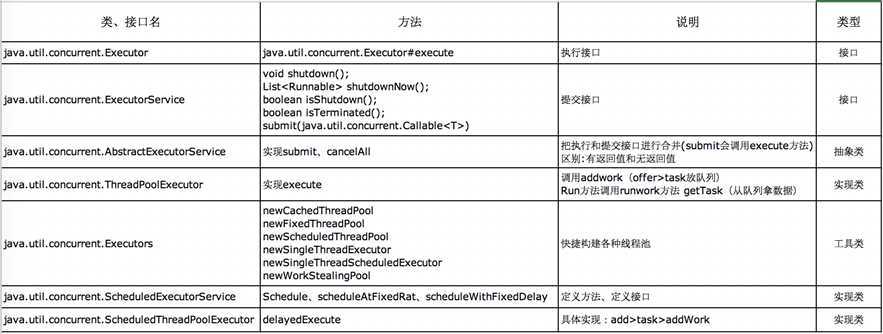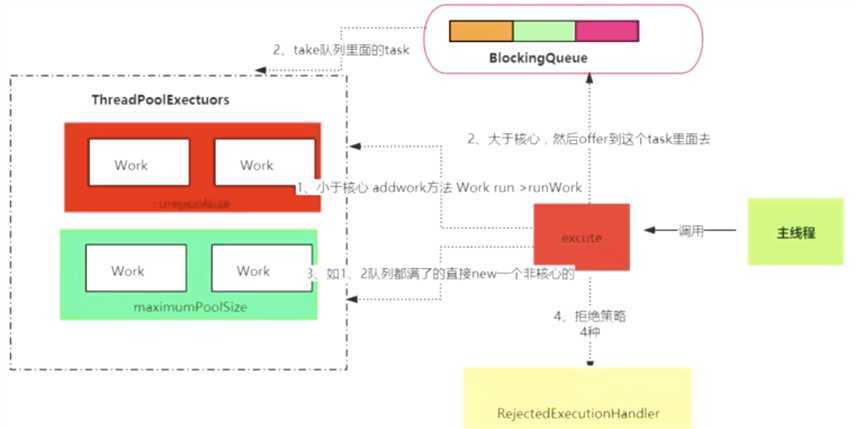一、多线程详解
1、什么是线程
线程是一个操作系统概念。操作系统负责这个线程的创建、挂起、运行、阻塞和终结操作。而操作系统创建线程、切换线程状态、终结线程都要进行CPU调度——这是一个耗费时间和系统资源的事情。
2、线程生命周期
Java当中,线程通常都有五种状态,创建、就绪、运行、阻塞和死亡:

可以用过jstack 或者idea debug快照显示状态,常见名词大致意思为:
3、线程状态描述
要区分 BLOCKED 和 WATING 的区别, 一个是在临界点外面等待进入, 一个是在理解点里面wait等待别人notify, 线程调用了join方法 join了另外的线程的时候, 也会进入WAITING状态, 等待被他join的线程执行结束。核心区别就是BLOCKED没拿到锁,WAITING拿到了锁。
4、线程优先级Priority
线程的优先级是将该线程的重要性传给了调度器、cpu处理线程顺序有一定的不确定,但是调度器会倾向于优先权高的先执行。
5、线程实现方式
线程有三种实现方式:Thread、Runnable、Callable。
Thread实现方式代码如下:
public class Thread01 extends Thread { @Override public void run() { System.out.println("Thread 方式创建线程"); } public static void main(String[] args) throws InterruptedException { new Thread01().start();//多线程 } }
Runnable实现方式:
public class Runnable01 implements Runnable { @Override public void run() { System.out.println("Runnable方式创建线程"); } public static void main(String[] args) { new Thread(new Runnable01()).start(); } }
Callable实现方式:
public class Callable01 implements Callable<String> { @Override public String call() throws Exception { System.out.println("Callable方式创建线程"); return "Callable"; } public static void main(String[] args) throws ExecutionException, InterruptedException { FutureTask task=new FutureTask(new Callable01());//有参 赋值 成员属性 new Thread(task).start(); System.out.println( task.get());; } }
6、Thread和Runnable的联系与区别
public class Thread implements Runnable { // 省略 @Override public void run() { if (target != null) { target.run(); } } // 省略 }
综上所述:Thread和Runnable的实质是继承关系,没有可比性。无论使用Runnable还是Thread,都会new Thread,然后执行run方法。用法上,如果有复杂的线程操作需求,那就选择继承Thread,如果只是简单的执行一个任务,那就实现runnable。
7、Callable原理是什么
Callable 1.5引入,具有返回值,并且支持泛型:
public interface Callable<V> { V call() throws Exception; }
返回加入泛型既可以返回Object,也可以让调用限定类型,更灵活。Callble相关源码如下:
public interface Future<V> { boolean cancel(boolean mayInterruptIfRunning); boolean isCancelled(); boolean isDone(); V get() throws InterruptedException, ExecutionException; V get(long timeout, TimeUnit unit) throws InterruptedException, ExecutionException, TimeoutException; } public interface RunnableFuture<V> extends Runnable, Future<V> { void run(); } public class FutureTask<V> implements RunnableFuture<V> {
private Callable<V> callable; public void run() { if (state != NEW || !RUNNER.compareAndSet(this, null, Thread.currentThread())) return; try { Callable<V> c = callable; if (c != null && state == NEW) { V result; boolean ran; try { result = c.call(); ran = true; } catch (Throwable ex) { result = null; ran = false; setException(ex); } if (ran) set(result); } } finally { // runner must be non-null until state is settled to // prevent concurrent calls to run() runner = null; // state must be re-read after nulling runner to prevent // leaked interrupts int s = state; if (s >= INTERRUPTING) handlePossibleCancellationInterrupt(s); } } }
我们在使用以下代码构建task时,实际上在FutureTask类的构造方法就给自己的属性callable进行了赋值。
FutureTask task=new FutureTask(new Callable01());
而可以看到FutureTask实际上也是一个Runnable的具体实现,因此可以使用以下方法进行task执行(和Runnable的使用方式一致):
new Thread(task).start();
调用start方法,实际上就是调用Runnable的run方法,因此调用了FutureTask的run方法,然后这个新起的线程采用方法调用方式调用了具体Callable实现类的call方法,并将返回值进行set,因此我们可以通过task.get()方法获取执行结果。
8、和使用线程池有什么不一样
看以下代码:
public class ThreadPkTest { public static void main(String[] args) throws InterruptedException { Long start= System.currentTimeMillis(); final List<Integer> l=new ArrayList<Integer>(); final Random random=new Random(); for(int i=0;i<10000;i++){ Thread thread=new Thread(){ public void run(){ l.add(random.nextInt()); } }; thread.start(); thread.join(); } System.out.println("直接创建线程执行时间:"+(System.currentTimeMillis()-start)); System.out.println("size:"+l.size()); start= System.currentTimeMillis(); final List<Integer> list=new ArrayList<Integer>(); ExecutorService executorService= Executors.newSingleThreadExecutor();for(int i=0;i<10000;i++){ executorService.execute(new Runnable() { @Override public void run() { list.add(random.nextInt()); } }); } executorService.shutdown(); executorService.awaitTermination(1, TimeUnit.DAYS); System.out.println("线程池执行时间:"+(System.currentTimeMillis()-start)); System.out.println("size:"+list.size()); } }
执行结果如下:
直接创建线程执行时间:1601 size:10000 线程池执行时间:33 size:10000
由此可以对比线程池效率要高出很多,是什么原因呢?大致有这么几点:
那我们接下来就核心进行线程池的研究。
二、线程池代码详解
1、线程池使用示例
首先我们来看下如何使用线程池,线程持有submit以及execute两种写法,代码如下:
public class ThreadPool01 { public static void main(String[] args) { ExecutorService executorService = Executors.newCachedThreadPool(); executorService.submit(()-> System.out.println("Submit方式执行optimized")); executorService.submit(new Runnable() { @Override public void run() { System.out.println("Submit方式执行"); } }); executorService.execute(()-> System.out.println("Execute方式执行optimized")); executorService.execute(new Runnable() { @Override public void run() { System.out.println("Execute方式执行"); } }); executorService.shutdown(); } }
2、线程池类、接口
然后我们来看看线程池有哪些类与接口,核心如图所示:

如图所示,有这么一些重要的接口与类,如下表所示:

3、线程池执行流程
3.1、初始化ThreadPoolExecutor
不管我们是通过Executors工具类快速初始化线程池,还是手动配置线程池参数,我们第一不都是初始化线程池:
ExecutorService executorService = Executors.newCachedThreadPool(); //快速构建 ExecutorService es = new ThreadPoolExecutor(5, 5, //手动构建 0L, TimeUnit.MILLISECONDS, new SynchronousQueue<Runnable>(), Executors.defaultThreadFactory())
参数详情如下:
public ThreadPoolExecutor( int corePoolSize, //核心线程数大小 - 10 int maximumPoolSize, //最大线程数 - 100 long keepAliveTime, //非核心线程存活时间 TimeUnit unit, //时间单位 BlockingQueue<Runnable> workQueue, //存放任务的阻塞队列 ThreadFactory threadFactory, //创建线程的工厂 RejectedExecutionHandler handler //拒绝策略 )
3.2、调用execute、submit执行
我们知道有两种方式,分别是submit和execute,但是底层核心都是调用execute,无非是submit有返回,execute无返回。代码如下:
public <T> Future<T> submit(Runnable task, T result) { if (task == null) throw new NullPointerException(); RunnableFuture<T> ftask = newTaskFor(task, result); execute(ftask); return ftask; }
但是其实execute和submit还有点不同,就是task类型不一样,submit类型是FutureTask,而execute的task类型是线程池运行的run方法所属类的类型。
3.3、核心、非核心线程协作原理
如execute方法中的代码所示:
public void execute(Runnable command) { if (command == null) throw new NullPointerException(); int c = ctl.get(); if (workerCountOf(c) < corePoolSize) { if (addWorker(command, true)) return; c = ctl.get(); } if (isRunning(c) && workQueue.offer(command)) { int recheck = ctl.get(); if (! isRunning(recheck) && remove(command)) reject(command); else if (workerCountOf(recheck) == 0) addWorker(null, false); } else if (!addWorker(command, false)) reject(command); }
如上四处代码,如下图所示四种不同规则所示:

所以当一个任务通过execute(Runnable)方法添加到线程池时:
综上所述:处理任务的优先级为:核心线程corePoolSize、任务队列workQueue、最大线程maximumPoolSize,如果三者都满了,使用handler处理被拒绝的任务。
3.4、创建Worker对象addWorker
Worker是一个实现了Runnable接口的类,Worker的执行最终会调用我们提交的任务中的run()方法。
private final class Worker extends AbstractQueuedSynchronizer implements Runnable {}
创建Worker对象代码如下:
private boolean addWorker(Runnable firstTask, boolean core) { retry: for (int c = ctl.get();;) { // Check if queue empty only if necessary. if (runStateAtLeast(c, SHUTDOWN) && (runStateAtLeast(c, STOP) || firstTask != null || workQueue.isEmpty())) return false; for (;;) { if (workerCountOf(c) >= ((core ? corePoolSize : maximumPoolSize) & COUNT_MASK)) return false; if (compareAndIncrementWorkerCount(c)) break retry; c = ctl.get(); // Re-read ctl if (runStateAtLeast(c, SHUTDOWN)) continue retry; // else CAS failed due to workerCount change; retry inner loop } } boolean workerStarted = false; boolean workerAdded = false; Worker w = null; try { w = new Worker(firstTask); final Thread t = w.thread; if (t != null) { final ReentrantLock mainLock = this.mainLock; mainLock.lock(); try { // Recheck while holding lock. // Back out on ThreadFactory failure or if // shut down before lock acquired. int c = ctl.get(); if (isRunning(c) || (runStateLessThan(c, STOP) && firstTask == null)) { if (t.isAlive()) // precheck that t is startable throw new IllegalThreadStateException(); workers.add(w); int s = workers.size(); if (s > largestPoolSize) largestPoolSize = s; workerAdded = true; } } finally { mainLock.unlock(); } if (workerAdded) { t.start(); //此处会调用Worker这个Thread包装类的start方法,start方法会调用run方法,run方法会调用runWorker方法。 workerStarted = true; } } } finally { if (! workerStarted) addWorkerFailed(w); } return workerStarted; }
3.5、启动worker对象
启动worker对象如下代码所示:
final void runWorker(Worker w) { Thread wt = Thread.currentThread(); Runnable task = w.firstTask; w.firstTask = null; w.unlock(); // allow interrupts boolean completedAbruptly = true; try { while (task != null || (task = getTask()) != null) { w.lock(); // If pool is stopping, ensure thread is interrupted; // if not, ensure thread is not interrupted. This // requires a recheck in second case to deal with // shutdownNow race while clearing interrupt if ((runStateAtLeast(ctl.get(), STOP) || (Thread.interrupted() && runStateAtLeast(ctl.get(), STOP))) && !wt.isInterrupted()) wt.interrupt(); try { beforeExecute(wt, task); try { task.run(); afterExecute(task, null); } catch (Throwable ex) { afterExecute(task, ex); throw ex; } } finally { task = null; w.completedTasks++; w.unlock(); } } completedAbruptly = false; } finally { processWorkerExit(w, completedAbruptly); } }
Worker启动后,会执行我们提交的任务的run()方法,执行完成后会调用finally中的 processWorkerExit 方法。
private void processWorkerExit(Worker w, boolean completedAbruptly) { if (completedAbruptly) // If abrupt, then workerCount wasn‘t adjusted decrementWorkerCount(); final ReentrantLock mainLock = this.mainLock; mainLock.lock(); try { completedTaskCount += w.completedTasks; workers.remove(w); } finally { mainLock.unlock(); } tryTerminate(); int c = ctl.get(); if (runStateLessThan(c, STOP)) { if (!completedAbruptly) { int min = allowCoreThreadTimeOut ? 0 : corePoolSize; if (min == 0 && ! workQueue.isEmpty()) min = 1; if (workerCountOf(c) >= min) return; // replacement not needed } addWorker(null, false); } }
由此可知,调用循环进入到了3.4。
4、什么是Worker
6、Java中提供的几种快捷线程池
原文:https://www.cnblogs.com/jing99/p/12670974.html